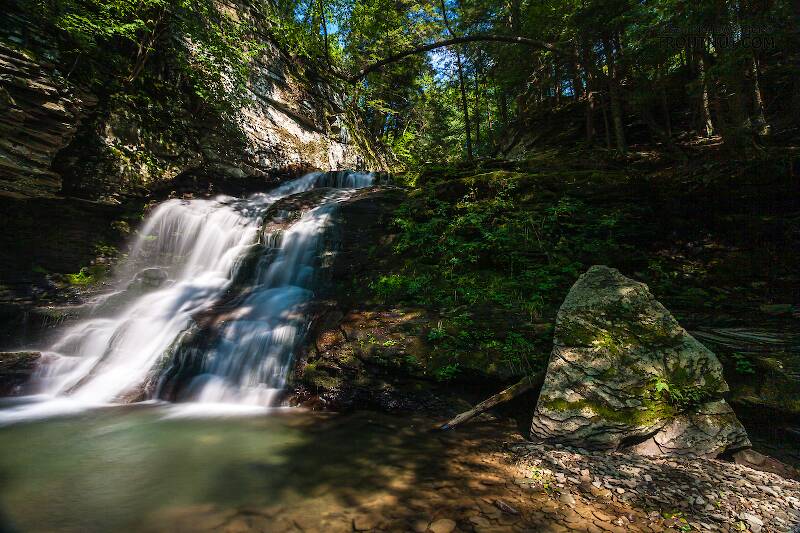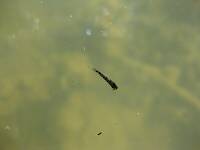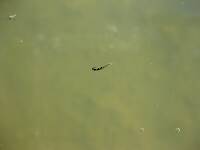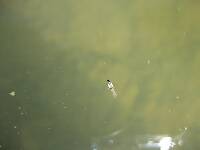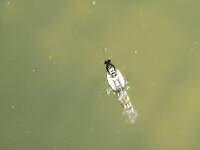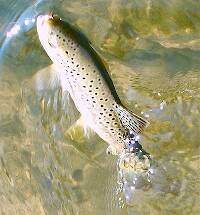
Salmonflies
Pteronarcys californica
The giant Salmonflies of the Western mountains are legendary for their proclivity to elicit consistent dry-fly action and ferocious strikes.
Featured on the forum

Troutnut is a project started in 2003 by salmonid ecologist Jason "Troutnut" Neuswanger to help anglers and
fly tyers unabashedly embrace the entomological side of the sport. Learn more about Troutnut or
support the project for an enhanced experience here.
Martinlf on Nov 23, 2015November 23rd, 2015, 8:02 am EST
Could someone explain the science behind the hypothesis that a caddis exits the surface more quickly because it is "more developed due to its having gone through the pupal stage"? From what I understand of evolution, the speed of exit from the water's surface could conceivably be faster in an insect exhibiting hemimetabolism than one exhibiting holometabolism, depending on many environmental and developmental variables.
"He spread them a yard and a half. 'And every one that got away is this big.'"
--Fred Chappell
--Fred Chappell
PaulRoberts on Nov 23, 2015November 23rd, 2015, 8:13 am EST
From the "Caddis Pupa Question" thread:
http://www.garyborger.com/2010/01/07/caddis-pupa-husk/
Gary Borger says:
Hi Paul, No one that I know of in the scientific literature has seen caddis pupa pumped full of gasses. They have seen and clearly showed that there is molting fluid between the pupal husk and the enclosed adult and that it makes the pupa glisten. The diving adults certainly have a encasing air bubble, which may in fact be the reason that some anglers believe that the caddis emergence is instantaneous.
http://www.garyborger.com/2010/01/07/caddis-pupa-husk/
Gary Borger says:
Hi Paul, No one that I know of in the scientific literature has seen caddis pupa pumped full of gasses. They have seen and clearly showed that there is molting fluid between the pupal husk and the enclosed adult and that it makes the pupa glisten. The diving adults certainly have a encasing air bubble, which may in fact be the reason that some anglers believe that the caddis emergence is instantaneous.
Martinlf on Nov 23, 2015November 23rd, 2015, 8:33 am EST
OK, so we have a number of irons in the fire here. Paul is suggesting that the caddis that exit quickly are likely adult egg layers returning to the surface and flying off quickly. That makes sense to me.
However, in another thread, Ralph Cutter says he's seen caddis inflate with a gas. He notes that not all do, but some have exhibited this trait, and he says Lafontaine differentiates between them correctly.
Note that Cutter says, "expand with air." I've pretty much taken Borger's word on the inflated caddis question, but wonder what Cutter saw. His comments seem to be more anecdotal than derived from a controlled study, and I don't know if anyone has published a study to confirm or disprove them.
Finally, has anyone published anything comparing the emergence of mayflies and caddis under comparable conditions? It would take a relatively broad study to produce generalizations about the emergence of these two different bugs. Is the assumption that most? or all? caddis exit the surface faster than mayflies just that, an assumption? And what do we make of the caddis that run across the surface after emergence?
However, in another thread, Ralph Cutter says he's seen caddis inflate with a gas. He notes that not all do, but some have exhibited this trait, and he says Lafontaine differentiates between them correctly.
A reference was made to my video Bugs of the Underworld and the author identified the emerging caddis pupa as a Hydropsychid. It is actually a Banksiola crotchi, one of the Phryganeidae. This section was filmed in British Columbia. I chose these guys to film because they are huge - nearly two inches, and they emerge VERY slowly which makes them ideal for studying the emergence behavior on film. They do not form a bubble, but have extremely strong swimmerets they use to stroke and swim to the surface.
The still photograph is a caddis pupae in Manzanita Lake in N. California. I am not sure of the species. It just popped up out of the weeds and swam around in a few lazy circles then went to the surface and emerged. It was the only caddis of the day. Pure luck to get him. When he (she?) first came out of the weeds it was solid brown, but very quickly two bulges appeared on his thorax and expand with air. The tight cuticle both reflected the light when viewed from above and sparkled with an inner glow when seen in profile and from below. The cuticle is pretty transparent and easily lets the light pass.
MANY caddis form these bubbles under the cuticle, but just as many don't. Gary's book Caddisflies is fairly accurate when he describes which species to imitate with sparkle yarn and which species to not use sparkle yarn (Antron).
Note that Cutter says, "expand with air." I've pretty much taken Borger's word on the inflated caddis question, but wonder what Cutter saw. His comments seem to be more anecdotal than derived from a controlled study, and I don't know if anyone has published a study to confirm or disprove them.
Finally, has anyone published anything comparing the emergence of mayflies and caddis under comparable conditions? It would take a relatively broad study to produce generalizations about the emergence of these two different bugs. Is the assumption that most? or all? caddis exit the surface faster than mayflies just that, an assumption? And what do we make of the caddis that run across the surface after emergence?
"He spread them a yard and a half. 'And every one that got away is this big.'"
--Fred Chappell
--Fred Chappell
Byhaugh on Nov 23, 2015November 23rd, 2015, 8:48 am EST
I'm pretty sure that the fleeing adult caddis I have seen were part of a hatch and not the "reverse hatch" I call the ovipositing females...........
PaulRoberts on Nov 23, 2015November 23rd, 2015, 9:42 am EST
You know... just looking at mayfly wings vs caddis wings...
Mayflies wings are aerodynamically different, would appear to have a much higher aspect ratio making the animal slower in flight in general, compared to the caddis wing. Apparently it has worked well enough for the ancient may's that they have had no significant pressure to overcome historical constraints on wing structure. There may also be -likely are- good reasons to keep such a wing... I'm thinking about what those wings end up being used for: mating (which I believe mostly occurs in flight?) and egg-laying -the often vertical dances over riffles.
Caddis live much longer than mays, feed actively, and must keep those wings for a longer period.
"Why's" are often deeper than we are often aware of.
Just thinking out loud.
Mayflies wings are aerodynamically different, would appear to have a much higher aspect ratio making the animal slower in flight in general, compared to the caddis wing. Apparently it has worked well enough for the ancient may's that they have had no significant pressure to overcome historical constraints on wing structure. There may also be -likely are- good reasons to keep such a wing... I'm thinking about what those wings end up being used for: mating (which I believe mostly occurs in flight?) and egg-laying -the often vertical dances over riffles.
Caddis live much longer than mays, feed actively, and must keep those wings for a longer period.
"Why's" are often deeper than we are often aware of.
Just thinking out loud.
Byhaugh on Nov 23, 2015November 23rd, 2015, 11:06 am EST
Yes, when I mentioned caddisflies flies having two sets of wings as a possible difference in emergence, someone replied that mayflies also have two sets of wings. I don't think the small "aft wings" of the mayfly compare to the prominent double set of separately functioning tricoptera wings?
I also wonder if the "hairy" nature of the moth-like Caddis wings might somehow e a factor in their ability to leave the water quickly following emergence?
I also wonder if the "hairy" nature of the moth-like Caddis wings might somehow e a factor in their ability to leave the water quickly following emergence?
Crepuscular on Nov 23, 2015November 23rd, 2015, 11:14 am EST
Could someone explain the science behind the hypothesis that a caddis exits the surface more quickly because it is "more developed due to its having gone through the pupal stage"? From what I understand of evolution, the speed of exit from the water's surface could conceivably be faster in an insect exhibiting hemimetabolism than one exhibiting holometabolism, depending on many environmental and developmental variables.
This whole thread lacks any "real science". What is the scientific tie between evolution and the speed of exit from the water's surface? I simply stated that a pharate adult caddis has already developed very usable legs and wings which allow it be a strong swimmer. Is it easier to break through surface tension with an object that is relatively motionless or with one that has a greater force behind it?
For those caddis that do actually emerge faster than some mayflies, it really has to due with development prior to reaching the surface. By the way there are plenty of mayflies that leave the surface quickly as well and really I think that making the a blanket statement like all caddis flies leave the surface faster than mayflies is incorrect.
All I meant, and I apologize if it wasn't clear is that if it is indeed true that caddis emerge faster than mayflies (which overall I doubt is the case) the breaking the surface tension may be easier for a fully developed insect than one this is in the throws of emerging from the water and undergoing a life stage change. And since somewhat isolated observations apparently are considered "scientific fact" by some in the angling world just because no one else has bothered to look before, or after these postulates are taken as doctrine. Can I say that all caddis emerge slow because I have fished plenty of Grannom hatches when the air temps are cold or the water is cold or for whatever reason those emerging adult caddis float down the surface of the stream until they are out of sight, never taking flight while they were visible to me. Not quite. Like you pointed out Louis, environmental and species specific variables are at work here and thus one should be careful when making blanket statements in entomological conversations.
Byhaugh on Nov 23, 2015November 23rd, 2015, 2:33 pm EST
I certainly don't dispute much of what is posted herein.
I am still left with the question which I thought, in this day and age (as they say), would be pretty much resolved.
I found the quote of Gary Borger, posted above, very plausible concerning the air bubble belonging to ovipositing females rather than the initial hatch of caddis flies.
However, I still wonder about the initial hatch of caddis.
Apparently, there is much disagreement as to the premise that the initial hatch of "most" caddis is quicker OFF THE SURFACE than "most" mayflies.
Then, there seems to be disagreement as to WHY, if you accept the premise that the initial caddis hatch is quicker, it occurs quicker.
Seems, after all these years, and all these books and articles on the subject, there would, by now, be generally accepted answers.
I know that I used to raise insects in a big fish tank in my basement and watch them hatch. Unfortunately, I was studying mayflies and stoneflies and not caddis flies. Seems it could be done pretty easily.
I am still left with the question which I thought, in this day and age (as they say), would be pretty much resolved.
I found the quote of Gary Borger, posted above, very plausible concerning the air bubble belonging to ovipositing females rather than the initial hatch of caddis flies.
However, I still wonder about the initial hatch of caddis.
Apparently, there is much disagreement as to the premise that the initial hatch of "most" caddis is quicker OFF THE SURFACE than "most" mayflies.
Then, there seems to be disagreement as to WHY, if you accept the premise that the initial caddis hatch is quicker, it occurs quicker.
Seems, after all these years, and all these books and articles on the subject, there would, by now, be generally accepted answers.
I know that I used to raise insects in a big fish tank in my basement and watch them hatch. Unfortunately, I was studying mayflies and stoneflies and not caddis flies. Seems it could be done pretty easily.
Taxon on Nov 23, 2015November 23rd, 2015, 4:09 pm EST
I found the quote of Gary Borger, posted above, very plausible concerning the air bubble belonging to ovipositing females rather than the initial hatch of caddis flies.
That presupposes Gary LaFontaine would not have known the difference between an emerging caddisfly pupa and a diving caddisfly adult returning to the surface, which I believe is simply preposterous.
Apparently, there is much disagreement as to the premise that the initial hatch of "most" caddis is quicker OFF THE SURFACE than "most" mayflies.
I believe premise (that the initial hatch of "most" caddisflies is quicker OFF THE SURFACE than "most" mayflies) to be an indisputable fact.
Entoman on Nov 23, 2015November 23rd, 2015, 5:30 pm EST
Well, consider this. Many caddis emerge much slower than most mayflies. Even though they (mayflies) are apparently quite lazy...
"Ahhh... There is no agree! Dispute or dispute not..."
- Yoda -
"Ahhh... There is no agree! Dispute or dispute not..."
- Yoda -
"It's not that I find fishing so important, it's just that I find all other endeavors of Man equally unimportant... And not nearly as much fun!" Robert Traver, Anatomy of a Fisherman
PaulRoberts on Nov 24, 2015November 24th, 2015, 3:01 pm EST
That presupposes Gary LaFontaine would not have known the difference between an emerging caddisfly pupa and a diving caddisfly adult returning to the surface, which I believe is simply preposterous.
That's how I always felt, and am still... puzzled.
I simply stated that a pharate adult caddis has already developed very usable legs and wings which allow it be a strong swimmer. Is it easier to break through surface tension with an object that is relatively motionless or with one that has a greater force behind it?
A good point: that may's tend to be more feeble swimmers and tend to stand on the shuck -like a little boat- when emerging.
I have watched E pleuralis emerge and the they can come off pretty quick -or don't always spend lots of time on the surface, although it can often be chilly when they emerge which can slow them up.
Then there are strong swimming Isonychia, which usually emerge by crawling out onto cobbles. But I've also seen them emerge midstream on runs and they aren't particularly faster getting out of the shuck and flying off. Seems they too spend some time stepping out of the shuck.
Further, it strikes me that the exuvia of the subimago slows may's up in flight. Imagoes, upon return, are stronger fliers, but not like adult caddis are.
Byhaugh on Nov 24, 2015November 24th, 2015, 4:22 pm EST
Is it just me that can't understand why there isn't general agreement on any of these questions relating to the difference in caddis hatching and mayfly hatching?
Is there not a single comprehensive "scientific" "textbook" on the subject?
I have a pretty large library of large volumes on fly fishing entomology and I find they don't agree on some very basic issues.
It may be that they are written by fly fishermen turned entomologists?????
Is there not a single comprehensive "scientific" "textbook" on the subject?
I have a pretty large library of large volumes on fly fishing entomology and I find they don't agree on some very basic issues.
It may be that they are written by fly fishermen turned entomologists?????
Wbranch on Nov 24, 2015November 24th, 2015, 5:07 pm EST
You can surely tell when the fishing season has wound down to nothing and we are all sitting at the computer kind of bored and willing to the debate minutiae of air bubbles, gas bubbles, and why certain bugs rise to the surface faster than others.
I'm sure for the full time entomologists and the forum members who really enjoy the study of bugs this is fascinating stuff but for guys like me who ties flies because I love to catch fish on the flies I tie these conversations just make me smile.
I'm sure for the full time entomologists and the forum members who really enjoy the study of bugs this is fascinating stuff but for guys like me who ties flies because I love to catch fish on the flies I tie these conversations just make me smile.
Catskill fly fisher for fifty-five years.
Creno on Nov 24, 2015November 24th, 2015, 5:13 pm EST
Wbranch - I don't think the entomologists find it all that fascinating either. Seems some folks are looking for an absolute generality....... and others are stuck trying to understand the bubbles. Both may be interesting on their own although probably without solution. That is the "nature" of nature.
Martinlf on Nov 24, 2015November 24th, 2015, 5:29 pm EST
Yes. But one thing that I (re?)learned is not to assume that a caddis popping off the water has just hatched. My brother-in-law had a great day fishing to egg laying caddis this fall using wet flies. A buddy of his had figured it out the day before, and tipped him off. A discussion such as this one helps me to try to store this kind of information, and sometimes in the middle of a frustrating day something comes back to save it. So thanks to all who weighed in.
"He spread them a yard and a half. 'And every one that got away is this big.'"
--Fred Chappell
--Fred Chappell
Wbranch on Nov 24, 2015November 24th, 2015, 5:30 pm EST
Creno wrote;
Haha, sounds like the consummate oxymoron.
Seems some folks are looking for an absolute generality.......
Haha, sounds like the consummate oxymoron.
Catskill fly fisher for fifty-five years.
Taxon on Nov 24, 2015November 24th, 2015, 5:33 pm EST
Byron-
Perhaps you are stuck with an unrealistic expectation. My observation is that it is not unusual for scientists to not be in "general agreement", and even when they are, that doesn't necessarily guarantee they are correct.
Is it just me that can't understand why there isn't general agreement on any of these questions relating to the difference in caddis hatching and mayfly hatching?
Perhaps you are stuck with an unrealistic expectation. My observation is that it is not unusual for scientists to not be in "general agreement", and even when they are, that doesn't necessarily guarantee they are correct.
Wbranch on Nov 24, 2015November 24th, 2015, 5:38 pm EST
Louis wrote;
I'm so old, and forgetful, that if I had to rely on my memory of how I succeeded during a tough day on the river twenty years ago I'd probably be standing in the middle of the river motionless while undergoing a meltdown of the few remaining brain cells working overtime to recall some data.
Luckily most of the magic stills comes naturally without having to apply very much thought. Considering I carry hundreds of hatch specific flies with me (according to the time of the year when I expect to see them) I pretty much have it covered for fly selection and when one life cycle doesn't work I tie on another. When that fails I sit on the bank, light a smoke, and wait for more aggressive rising fish.
A discussion such as this one helps me to try to store this kind of information, and sometimes in the middle of a frustrating day something comes back to save it
I'm so old, and forgetful, that if I had to rely on my memory of how I succeeded during a tough day on the river twenty years ago I'd probably be standing in the middle of the river motionless while undergoing a meltdown of the few remaining brain cells working overtime to recall some data.
Luckily most of the magic stills comes naturally without having to apply very much thought. Considering I carry hundreds of hatch specific flies with me (according to the time of the year when I expect to see them) I pretty much have it covered for fly selection and when one life cycle doesn't work I tie on another. When that fails I sit on the bank, light a smoke, and wait for more aggressive rising fish.
Catskill fly fisher for fifty-five years.
Martinlf on Nov 24, 2015November 24th, 2015, 9:05 pm EST
When that fails I sit on the bank, light a smoke, and wait for more aggressive rising fish.
Yes, sitting on the bank, watching the water, is rarely a bad idea.
"He spread them a yard and a half. 'And every one that got away is this big.'"
--Fred Chappell
--Fred Chappell
Afishinado on Nov 25, 2015November 25th, 2015, 2:10 am EST
Matt,
Next time, between puffs when sitting on the bank of the D River, count how many times do you observe mayflies drifting by like little sail boats: baetis, cornutas, hendricksons, sulphurs, stenos, isos, hebes, blah, blah.
During the early grannom hatch you will see them (caddis) all over the place (and also catch fish on any decent representative fly), but most other times there will be 5 - 10 - 20? times more mayflies observed in the drift.
After your smoke, flip over a few rocks and take note how many free-living larva and cased caddis you find under those rocks. Compare that number to the amount of mayfly nymphs observed. Tons of caddis, many more than mayflies most times.
No scientific data really needed to theorize that mayflies are much more likely to be found drifting on the surface, while caddisflies, even though they likely outnumber mayflies, are less prevalent drifting on the surface.
Most of the caddis you are likely to see are flying, or are egg-laying adults, or spent on the surface...not hatching.
I'm not saying one should ignore caddis during a hatch....quite the opposite. But the only consistent way I've fished a caddis hatch successfully, is with a great pupa pattern in the film, in the column, or near the bottom. The DSP & ESP patterns are the best caddis patterns I've ever fished.
I smoke too....way too much, actually.
Next time, between puffs when sitting on the bank of the D River, count how many times do you observe mayflies drifting by like little sail boats: baetis, cornutas, hendricksons, sulphurs, stenos, isos, hebes, blah, blah.
During the early grannom hatch you will see them (caddis) all over the place (and also catch fish on any decent representative fly), but most other times there will be 5 - 10 - 20? times more mayflies observed in the drift.
After your smoke, flip over a few rocks and take note how many free-living larva and cased caddis you find under those rocks. Compare that number to the amount of mayfly nymphs observed. Tons of caddis, many more than mayflies most times.
No scientific data really needed to theorize that mayflies are much more likely to be found drifting on the surface, while caddisflies, even though they likely outnumber mayflies, are less prevalent drifting on the surface.
Most of the caddis you are likely to see are flying, or are egg-laying adults, or spent on the surface...not hatching.
I'm not saying one should ignore caddis during a hatch....quite the opposite. But the only consistent way I've fished a caddis hatch successfully, is with a great pupa pattern in the film, in the column, or near the bottom. The DSP & ESP patterns are the best caddis patterns I've ever fished.
I smoke too....way too much, actually.
Quick Reply
Related Discussions
Topic
Replies
Last Reply
2
Nov 4, 2012
by Aszat
by Aszat
4
Apr 16, 2007
by GONZO
by GONZO

